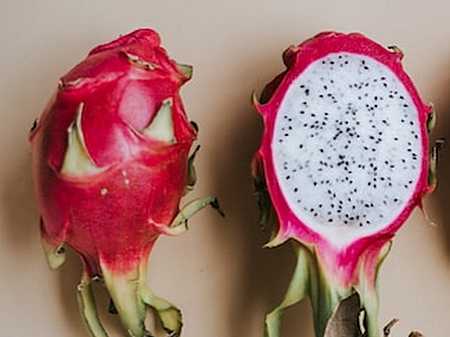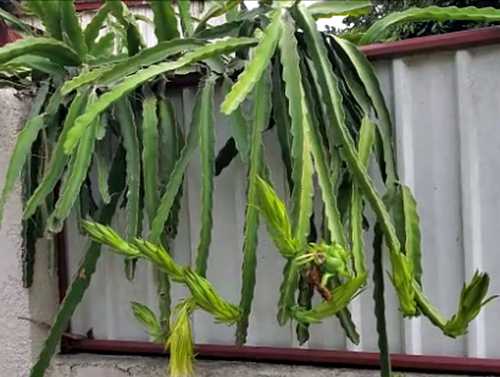Given below is a detailed guide on how to grow dragon fruit at home, from selecting the right variety to caring for your plants. Dragon fruit, also known as pitaya or pitahaya, strawberry pear, cactus fruit, Kaktus madu, Night-blooming cereus and Belle of the night belongs to cactus family. It is a unique and exotic fruit which is visually impressive and packed with nutritional benefit.
Dragon fruit is low in calories and high in fiber, antioxidants, vitamins and minerals. |
| Dragon Fruit |
The above picture shows a dragon fruit which looks very colorful and beautiful. The cut fruit shows many tiny seeds like that of a Kiwifruit.
Dragon Fruit Varieties
Dragon fruit comes in several varieties, each with its own unique appearance and flavor. The most common varieties grown in Australia and elsewhere include
- Hylocereus undatus (white-fleshed fruit),
- Hylocereus costaricensis or Hylocereus polyrhizus (red-purple fleshed fruit) and
- Hylocereus Selenicereus megalanthus (yellow skinned, white-fleshed fruit).
All these varieties need the same basic growing conditions.
Out of all the dragon fruit varieties, the yellow dragon fruit (hylocereus megalanthus) is the sweetest and is the most popular cactus among the world. The yellow pitaya is sweeter and juicier but smaller than the red-skinned variety.
The dragon fruit plant can handle heat, drought, humidity and poor soils as it is a cactus plant, but to produce juicy and tasty fruits it needs rich soil and regular watering.
Dragon Fruit Propagation
The most common method of dragon fruit propagation at home is by cuttings from a mature plant (how to grow dragon fruit from cuttings). However, it can also be grown from seeds (how to grow dragon fruit from seeds), but the plant may not produce fruit true to the parent.
Climate: Where it can be grown?
Dragon fruit plants come from Indonesia, Taiwan, Mexico and Central and Southern America, so they thrive in warm climates, in temperature ideally above 10°C (50°F) but below 38°C (100°F) with mild winters and no frost.
It can grow in various parts of Australia and in USDA hardiness zones 10-11 and other countries having tropical and subtropical climates. It can be grown in colder countries including UK and New Zealand in pots as an indoor plant or in raised mounds with covers.
Can you grow dragon fruit indoors? Yes, dragon fruit can also be grown indoors in a warm and sunny spot of the house. Place the pot near a sunny window so that the plant can receive the needed light. If you do not have such a place, then use grow lights to supplement natural light. Alice, Edgar's Baby, Seoul Kitchen, Yellow Dragon Fruit and Zamorano are the best dragon fruit varieties to grow indoors.
Sunlight Requirement
Dragon fruit plants are sun-loving and require plenty of sunlight to thrive. Choose a location where it can get full sun for at least six hours daily and protected from strong winds. If you are cultivating dragon fruit in a colder climate, consider growing them in containers so you can move them indoors during colder months.
Soil
It grows in any soil type but it needs to be free-draining. Ensure good drainage, waterlogged soils can lead to rot and kill your plant. Use a premium cacti and succulent soil mix or improve your soil by adding some river sand to make it sandy and free-draining. Also add some compost or composted manure to make the soil slightly acidic and nutrition rich.
 |
| Dragon Fruit or Pitaya Plant |
Watering
The dragon fruit can tolerate dry periods, it requires regular watering, especially during the growing season to grow flowers and fruit. However, it is essential not to overwater as they are susceptible to root rot. Always allow the soil to dry out between watering. Reduce the frequency of watering during the dormant season.
Support and Training
Dragon fruit plants are climbing cacti that require support as they grow. Provide a sturdy support structure like a trellis or stakes for the plant to climb and grow vertically. As the plant grows, secure the branches to the support to encourage growth.
The branches should hang over the support system, down for easy maintenance and harvest.
Fertilization
Dragon fruit plant is not heavy feeder, so avoid excessive fertilizer application.
Use a balanced, slow-release fertilizer during the growing season. A N-P-K 2-7-7 or 8-4-6 fertilizer is good for promoting flowering and fruiting.
Top dress with compost or decomposed cow manure in spring. Feed a liquid fertilizer in the growing period.
Pruning
Pruning is needed to maintain shape and size of the plants and for fruit production, otherwise the top will become heavy and congested.
- When the plant grows to about 1 m height, pinch the top to encourage side branching.
- To maintain the canopy size, keep no more than 50 main stems with 1-2 sub branches per main stem.
- Always prune after the harvesting.
- Fruit grows on new stems, so prune the older stems to make room for the new branches. Cut branches back to the original stem.
- Prune any unwanted side shoots to maintain a strong, well-shaped plant.
Pests and Diseases
- Dragon fruit are generally tough plants. But common pests like aphids, spider mites and scales may be the problem on dragon fruit plants.
- Neem oil spray can control the insect problems. The plants may be susceptible to rust and other fungal diseases in humid conditions.
- Good air circulation around the plant and avoiding overwatering and overhead watering can prevent fungal disease. Apply a copper-based spray to treat fungal problem.
- Bacterial infection may cause spots on the stems and leaves and may lead stem to rot. The plant may fight the bacterial infections and the spots may disappear after some time.
- Excessive watering or good rain when the fruit is ripening can split the fruit..
- Poorly draining soil can rot the roots and stems. Improving the soil drainage by mixing gypsum in the soil. Use a well draining potting mix as mentioned above.
Flowering
Dragon fruit will flower in summer. The flowers are very large about 20cm wide and are nocturnal, means they open at night and close during the day. The flower is yellowish green on the outside which opens to a stunning scented lily like white bloom. The flower opens for only one night that are pollinated by nocturnal insects and mammals.
 |
| Flower on Dragon Fruit |
After pollination, the oval-shaped green color fruit is formed which becomes ready to harvest about a month after flowering.
Harvesting Dragon Fruits
The dragon fruit will ripen approximately a month after flowering. Before picking the fruit, ensure that it is ripe because it will not ripen once picked.
Pick the fruit by twisting the fruit off the plant or cut with pruning shears. The ripe fruit easily detaches from the plant.
The fruit becomes bright pink, magenta or yellow skin colored with large showy bracts. The fruit weighs between 150-600g.
It is interesting to note that once the plant is mature, it will have four to six fruiting cycles a year, Also the dragon fruit plant is capable of bearing fruit for about 25 years.
Signs of Ripe Fruit
The color of the fruit should be bright and uniform all over and the small wings on the fruit are withering. Lightly press the fruit in your hand and if ripe it will give just a little.
The ripe fruit should feel slightly soft on touch.
How to Eat Dragon Fruit
Eat fresh dragon fruit fresh, just cut the fruit in half and then scooping out the flesh and use it in salads and smoothies.
Taste: The pulp of the fruit is white or purple containing tiny black seeds with a taste and texture similar to that of a kiwifruit.
Video on How To Grow Dragon fruit From Cuttings
how to propagate dragon fruit cuttings youtube video
fastest way to root dragon fruit cuttings in water youtube video